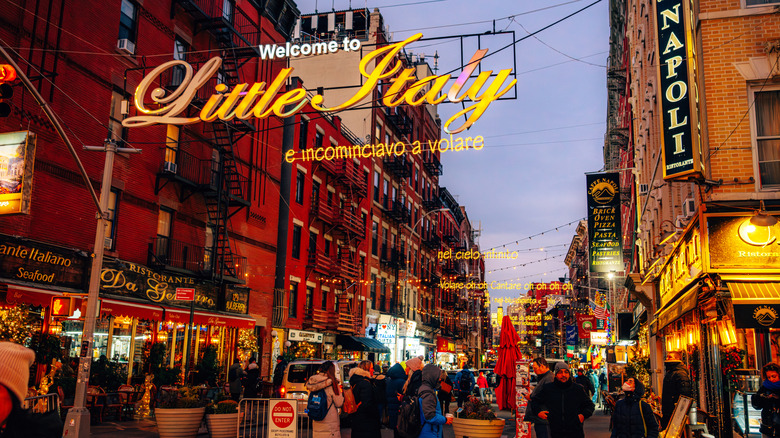
Nikada/Getty Images
History tells us that Italians were exploring the Americas as far back as the 1600s, and many were not only discovering new lands, but also settling here. Over the following centuries, thousands of people would make their way across the ocean seeking new opportunities in what would become the United States, particularly in the late 19th century and early 20th century. The newcomers brought with them the food, language, and customs that would help shape entire communities. Many of these “Little Italy” neighborhoods are still thriving today.
While some Italian enclaves in the U.S. have changed dramatically over the decades, thanks to urban development and waves of new residents, many still manage to retain their Old World charm. For example, if you stroll the streets of Little Italy in Manhattan or Boston’s North End, you’ll find traditional trattorias, corner bakeries, family-run butcher shops, and Italian grocery stores. If you’re looking for a taste of authentic Italian-American culture complete with delectable food, lively traditions, and plenty of neighborhood pride, most travelers and food lovers agree that these are the best Little Italy neighborhoods in the U.S.
1. North End in Boston, Massachusetts

Artography/Shutterstock
The story of Italian immigration in Boston is similar to many cities along the East Coast of the U.S. From about 1880 to 1920, over four million Italians left their home country for America to escape political upheaval, poverty, and the fallout of natural disasters. At that time, Boston already had a small Italian population, and according to the National Park Service, that number had grown to about 25,000 people by 1905. Many settled in the North End because it was closer to work sites on the docks and the city’s core.
Today, Boston’s North End is still a hub of Italian-American culture. Explore the cobblestone streets and you’ll find colonial-era buildings, European-style shops, and some of the best Italian restaurants in Boston. You can start your day with a cappuccino at the historic Caffe Vittoria, then head to Regina Pizzeria for a pizza made in the restaurant’s original oven that dates back to 1926. For dinner, you have a plethora of choices, including Ristorante Lucia for Abruzzo-style dishes like house-made pasta, Mama Maria for northern Italian cuisine, and Carmelina’s for Mediterranean seafood.
2. Little Italy in Manhattan, New York
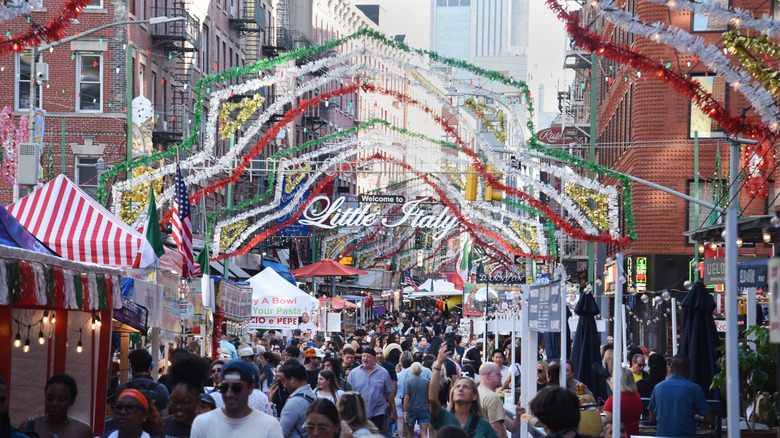
Joe Tabacca/Shutterstock
For many Italians immigrating to the United States around the turn of the 20th century, New York City was their first port of call. While some set off for different locales, the Library of Congress reports that about one-third of the newcomers settled in the city. The area around Mulberry Street in Lower Manhattan was particularly popular with Italian immigrants and came to be known as Little Italy. Today, it remains one of the most vibrant Little Italy neighborhoods in the country.
Some might say that Manhattan’s Little Italy is touristy, but it’s still worth visiting to experience a bit of Italian-American history and to hit up some of the best Italian restaurants in New York City. You’ll find all types of regional cuisine, from sweet treats like cannolis at Ferrara Bakery & Cafe to crispy crust pizzas with elevated toppings at Ceres Pizza, and luscious handmade pastas at Rubirosa. If you happen to come during the Feast of San Gennaro, you can enjoy tons of stellar food, music, and lively processions.
3. North Beach in San Francisco, California
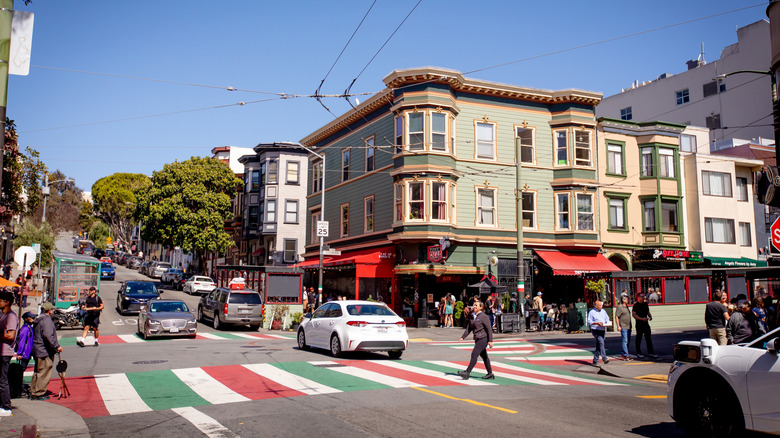
bluestork/Shutterstock
Italians have played an integral role in shaping San Francisco into what it is today. The first wave of immigrants started arriving in the 1840s. Some were lured west by the Gold Rush, while others came to make a living fishing, growing grapes, and running shops and restaurants. Many settled in the North Beach area, and today, the neighborhood (a.k.a., San Francisco’s Little Italy) is renowned for its excellent Italian bakeries, delis, restaurants, and wine bars.
If you’re looking for old-school vibes and food, make your way to Tommaso’s, a spot that’s been slinging wood-fired pizzas since 1935. Trattoria Contadina is a cozy spot that serves Italian classics like pasta and risotto with Italian wines. You can also tuck into fresh seafood dishes at Sotto Mare, sample divine desserts at Stella Pastry & Cafe, or try pies from world champion pizza maker Tony Gemignani at Tony’s Pizza Napoletana. If you’re looking for tasty bites to take away like meats, cheeses, and some seriously good Italian sandwiches, Molinari Delicatessan is your spot.
4. Little Italy in Cleveland, Ohio
Cleveland is another city that attracted large numbers of Italian immigrants, particularly in the early 20th century. According to Case Western Reserve, there were just 35 Italians listed on the 1870 census, and by 1960, there were over 19,000 first generation Italians living in the city. There were several Italian neighborhoods in Cleveland, but the one that lasted the longest and is still recognized as Little Italy today is on the east side of the city between Mayfield and Murray Hill Roads.
You’ll find plenty to explore in Cleveland’s Little Italy, including boutique shops, art galleries, and markets. History buffs can also visit The Italian American Museum of Cleveland. In addition, colorful events take place throughout the year, like the Feast of Assumption and ArtWalks. Of course, there are some great places to eat and drink. Standouts include Trattoria, which is renowned for house specialty pastas and pizzas; La Dolce Vita for its friendly atmosphere and fresh food; and Murray Street Market for its tasty sandwiches and imported Italian goods.
5. Little Italy in San Diego, California
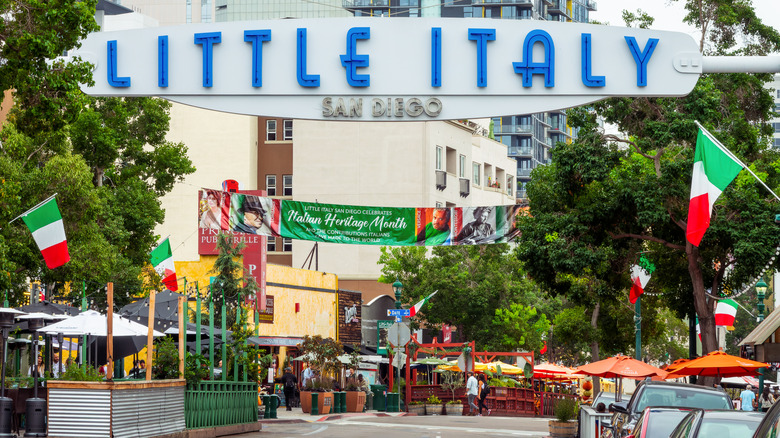
Delpixart/Getty Images
Prior to the 20th century, there were small pockets of Italians living in San Diego, many of whom fished for a living. Those numbers began to increase when the tuna industry picked up in the early 1900s. An Italian community grew in the northwest end of the city and was thriving by the 1920s. Sadly, the neighborhood went into decline when the tuna industry began drying up, and it faced another blow when a freeway was constructed in the area. However, community members pushed to revive it in the 1990s, and it’s been on an upswing ever since.
Today, San Diego’s Little Italy is a pleasant place to spend the day strolling through the Piazza della Famiglia and Amici Park, popping into shops, and stopping for bites to eat at the many cafes and restaurants. If it’s Italian you’re after, Isola gets great reviews for its pizzas cooked in wood burning ovens. Bencotto also earns accolades for its artisanal meat and cheese plates, handcrafted pastas, and great wine list. You can also find international bites like ceviche, kebabs, and burgers.
6. Arthur Avenue in the Bronx, New York

Little Vignettes Photo/Shutterstock
Manhattan may be known for its Little Italy, but many say the “real Little Italy” in New York City is Arthur Avenue in the Bronx. Also known as Belmont, the neighborhood was built around the P. Lorillard & Co. tobacco estate, which was established there in the 1760s. In the 1880s, many Italians moved to the neighborhood to work on construction projects for the New York Botanical Garden and the Bronx Zoo. Since then, it’s been a center of Italian food and culture.
You’ll never go hungry in the Bronx Little Italy, as the neighborhood is awash in pizzerias, pastry shops, delicatessens, butcher shops, and more. You can put together a killer charcuterie board at home with finds from Casa Della Mozzarella, the Calabria Pork Store, and Madonia Bakery. If you want a sit-down meal, Mario’s is great for old-school “red sauce” dishes. It’s also a must-visit restaurants for Soprano’s fans, as it was featured on the show. Other top spots include Tra Di Noi for seafood, Enzo’s for pasta and pizza, and Mike’s Deli for the eggplant parmigiana that beat Bobby Flay on “Throwdown with Bobby Flay.”
7. Little Italy in Baltimore, Maryland
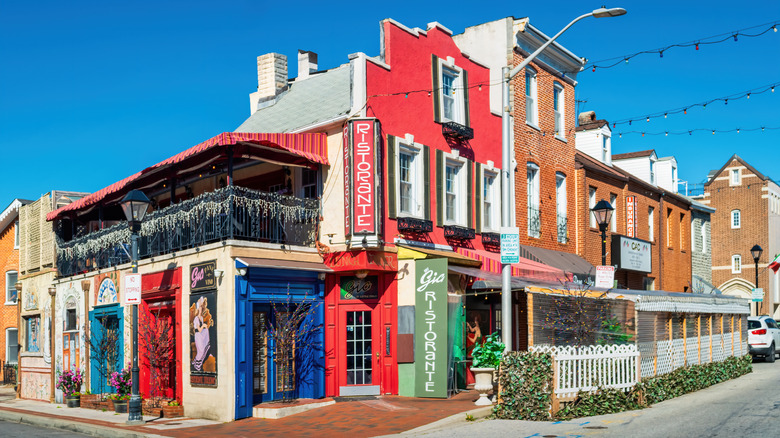
Benedek/Getty Images
While Ellis Island in New York City’s Harbor was the main port of entry for many Italian immigrants who made their way to America in the early 20th century, Baltimore’s port was just behind it in terms of numbers. Many new arrivals to Baltimore settled just east of the harbor in a neighborhood that was also home to many Irish, German, and Jewish families. As more Italians made their way to the city and opened businesses in the neighborhood, the area eventually came to be known as Little Italy.
Today, there are still families living in Baltimore’s Little Italy that can trace their heritage back to those early immigrants. There are also several businesses that have been around for generations. For example, Sabatino’s has been serving Italian-American fare like hearty layered lasagna and veal Parmigiana since 1953. Vaccaro’s Italian Pastry Shop has been serving sweets like cannolis, cookies, and gelato since 1956. There are also spots like La Scala and Costiera, whipping up modern Italian cuisine that get plenty of praise from diners.
8. The Hill in St. Louis, Missouri
While many Italian neighborhoods across the U.S. have faded over time, The Hill in St. Louis has managed to hold firmly onto its heritage. The neighborhood saw an influx of Italians from Sicily and Lombardi in the early 1900s, many of whom came to work in the clay mines. They built churches and started businesses like markets, bakeries, and trattorias. Today, generations of Italian-American families still call the neighborhood home, making it one of the most authentic Little Italy neighborhoods in the country.
Located close to the highest point in St. Louis, hence the name, The Hill offers plenty for locals and visitors alike. Brightly colored murals and crosswalks can be found throughout the 52-block neighborhood, and there are tons of shops and restaurants. For easy-going eats, Amighetti’s serves delicious Italian sandwiches on freshly baked bread. For a sit-down meal, you can’t go wrong with Cunetto House of Pasta for comforting pasta dishes; Pizzeria da Gloria for pizzas with beautiful crispy crusts; and Charlie Gitto’s for fine dining Italian fare.
9. 9th Street Italian Market in Philadelphia, Pennsylvania
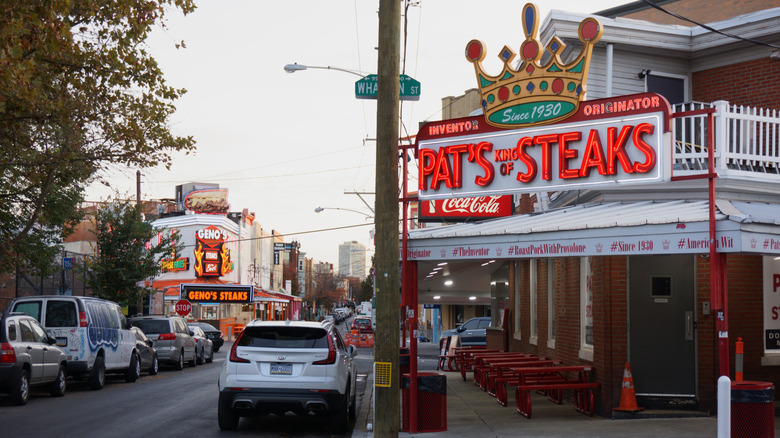
Bryan Littel/Shutterstock
Philadelphia’s Italian roots run deep. Records show that Italians were settling in the area as early as the 1660s. The population grew steadily over the centuries, but really exploded in the early 1900s when waves of Italians immigrated to the city. A large Italian community grew in South Philadelphia with many shops and restaurants popping up in an area that was later called the 9th Street Italian Market. The open-air market is still there today, and the market and surrounding area is a great place to soak up some Italian culture.
A visit to the 9th Street Italian Market can be a little overwhelming because it spans 20 city blocks and you’re simply spoiled for choices. You’ll find everything from cheese shops to bakeries, butcher shops, cafes, and sit-down restaurants. If you have limited time, a few must-visit spots include Ralph’s, which has been serving classic “red sauce” dishes since 1900; Sarcone’s Bakery for freshly baked bread and Sicilian pies; and Pat’s King of Steaks, the creator of the iconic Philly cheesesteak.
10. Bloomfield in Pittsburgh, Pennsylvania
The Bloomfield neighborhood of Pittsburgh was originally settled by English and German immigrants, but when large numbers of Italians moved to the area in the early 1900s to work in the growing number of factories, mines, and steel mills, it took on more of an Italian character. It’s still called Little Italy today, although the neighborhood has undergone many changes over the years. Now it has somewhat of a cosmopolitan vibe with many international cuisines on offer alongside Italian restaurants and cafes.
If you want a taste of old-school Bloomfield, Angelo’s Pizzeria has been making hand-crafted pizzas since 1976. The pies feature hand-stretched dough, house-made tomato sauce, meats, and provolone cheese. The Pleasure Bar has been around since 1949, and it serves Italian-American specialties like chicken Parmigiana, baked ziti, and meatball sandwiches. Some non-Italian spots in the neighborhood that get great reviews include Tessaro’s for its juicy burgers; Tram’s Kitchen for Vietnamese cuisine; and Apteka, which serves popular Pittsburgh-style pierogies, but with a vegan twist.
11. Federal Hill in Providence, Rhode Island
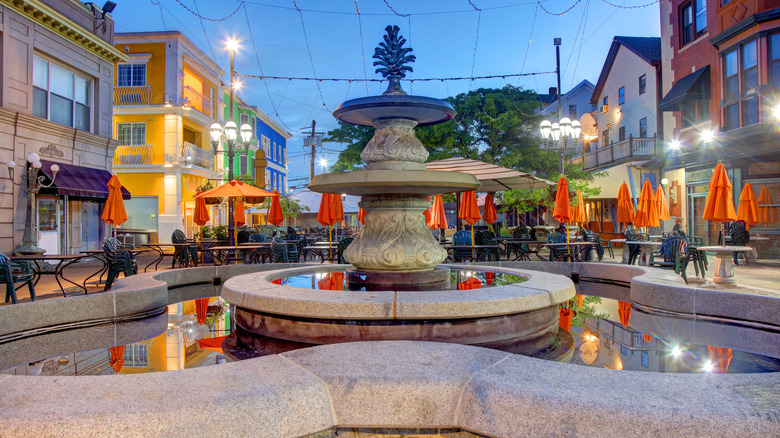
Denistangneyjr/Getty Images
The story of Italian immigration in Providence, Rhode Island, follows the same trajectory as many other cities along the East Coast. During the early 1900s, numerous Italians arrived seeking jobs in textile mills, foundries, and farms. Many settled in the Federal Hill neighborhood and opened businesses, including bakeries, barber shops, and general stores. That legacy remains today with plenty of shops and restaurants along Atwell Avenue and the streets surrounding DePasquale Square.
Federal Hill gives authentic Little Italy vibes with its striking stone fountain in the square and al fresco tables that line the streets in the summer months. If you happen to be visiting on a weekend, you can start the day with brunch at Il Massimo — indulge in dishes like cream and Nutella-filled Italian donuts called bombolini and crab cake eggs Benedict. Caserta Pizzeria is renowned for its pizzas and “Wimpy Skimpy” stuffed spinach pie, and Angelo’s Civita Farnese has been a local institution for classic Italian eats since 1924. Pane e Vino also gets called out for its flavorful pastas and comprehensive wine list.
12. Little Italy/University Village Chicago, Illinois

ChicagoPhotographer/Shutterstock
Chicago has a long history of Italian immigration that stretches back to the 1850s. Many Italian enclaves were established all over the city, but the biggest was on and around Taylor Street, earning the area the title of Little Italy. For many decades, the neighborhood thrived, but it began to decline in the 1950s after the Eisenhower Expressway was built, and more so when the University of Illinois in Chicago went up. Today, freshmen flock to the many international restaurants and bars in the area, but you can still find some old-school (and newer) Italian spots.
Although many of the best Italian restaurants in Chicago can be found scattered throughout the city’s neighborhoods, there are still some gems in Little Italy. Take Peanut Park Trattoria, which consistently earns accolades for its handmade pastas and hearty mains like the chicken Parmigiana. Pompei has been a Taylor Street favorite for its pizzas, pastas, and antipasto since 1909. If you want to try Chicago’s iconic Italian beef sandwich, Al’s No. 1 Italian Beef is a legend, having been a fixture in Little Italy since 1938.
13. Little Palermo in New Orleans, Louisiana
Italians had a presence in Louisiana long before New Orleans was even founded, but it wasn’t until the late 1800s that large waves of Sicilian immigrants began to arrive. Many settled in the French Quarter and surrounding areas, which earned the nickname “Little Palermo” in honor of their homeland. They left an indelible mark on the city, particularly the food scene. They imported olives and citrus fruit, introduced pasta dishes, and it was Sicilians who created the city’s iconic muffuletta sandwich.
There’s no specific area in New Orleans called Little Palermo, but you can see evidence of the Sicilian influence in many areas of the city. For example, you can visit the birthplace of the muffuletta at Central Grocery and Deli, which was founded by Sicilian immigrant Salvatore Lupo in 1906. The grand Hotel Monteleone was established in 1886 by a Sicilian cobbler named Antonio Monteleone. Come St. Joseph’s Day, altars around the city overflow with flowers, food, and figurines. There are also plenty of Italian restaurants that serve delectable Italian and Italian-Creole dishes.
14. Wooster Street in New Haven, Connecticut
Around the turn of the 20th century, New Haven, Connecticut, became another major hub for many Italian immigrants seeking new opportunities in America. Many settled around Wooster Street, where they built a close-knit community that would soon become famous for one thing in particular: apizza. This New Haven-style pizza was (and often still is) baked in coal-fired ovens and known for its thin, chewy crust and slightly charred edges. Over the years, Wooster Street has earned a legendary reputation as the epicenter of this regional specialty.
By far, the most famous of all the apizza spots is Frank Pepe Pizzeria Napoletana, which was founded by Naples native Frank Pepe in 1925. It became famous for its tasty pies, especially the white clam pizza with clams, fresh herbs, Pecorino Romano cheese, and olive oil. The restaurant is now a chain with several locations around the States, but the original is on Wooster Street. Other must-try Italian spots on the street include Consiglio’s for antipasta, pasta, and meats, and Libby’s Italian Pastry Shop for sweet treats.
Methodology

GEA Stock/Shutterstock
While there are many communities around the United States that have a strong Italian history and presence, these are the Little Italy neighborhoods that stand out for preserving their heritage in meaningful ways. We chose these neighborhoods because they continue to keep Italian culture alive in everyday life.
In each one, you’ll still find family-run restaurants serving recipes passed down for generations, old-school bakeries and butcher shops that are central to the community, and festivals that celebrate Italian traditions year after year. As for the restaurant recommendations, we did a deep-dive into customer reviews from the past year. We also found Reddit discussions about the best places to drink and dine in each place, and praise from national and local publications.


Dining and Cooking